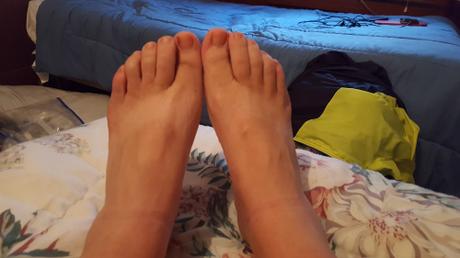Day 4 – Colebrook to North Stratford (cont.)
Even though our packs were lighter, having feet strike pavement (while admittedly carrying a little too much body weight) mile after mile, on top of Bartonella and Lyme damage, causes those feet to hurt at the end of the day.
A lot.
4 of my five kids with Lyme disease had Bartonella infections on top of their Lyme disease. I did too.
One glaring symptom of Bart is a strange rash. When I first saw the rash on one of my son’s back, I had thought it was the result of him slouching in a chair while he played video games hour, after hour.
“You need to sit up.”
I took him to his pediatrician who diagnosed him with stretch marks.
This boy – who ate a good diet and who was so skinny that if he didn’t wear a belt his pants would fall down had stretch marks? It looked like a wild animal had clawed his back – thick angry scar-like purple lines ran horizontally across his back.
They didn’t look like any stretch marks I had ever seen.
I mentioned this to our Lyme doctor at one of Griffin’s appointments and he asked to see my son. Sure enough, they weren’t stretch marks – it was a classic Bartonella rash.
Once I knew what to look for, I saw that rash on my other kids. Some had it under their armpits; some had it high on their thighs, another also had it on his back. Here’s the thing, ticks are not selective in the diseases they carry. They hold a veritable cesspool of different bacteria in their bellies ready to inject into your body with a bite. If you got Lyme disease (which we had all tested positive for) then the chances were very high you also got what is called a co-infection from these additional bacteria.
Go ahead and ask your local doc if he or she checks (or even knows how to check) for tick co-infections.
I’m willing to bet you’ll get nothing but a blank stare.
Meanwhile, people are suffering from virulent bacterial infections coursing unchecked through their bodies.
Some information on Bartonella from LymeDisease.org
“Historically, bartonellosis has been described as a mild, acute, and self-limiting illness. However, more and more doctors recognize that bartonella can cause chronic infection. Patients may suffer relapses because bartonella periodically cycles into red blood cells, which may provide a protective niche for the bacteria.
Early signs of bartonellosis include fever, fatigue, headache, poor appetite, and an unusual streaked rash that resembles “stretch marks” from pregnancy. Swollen glands are typical, especially around the head, neck and arms. Patients with bartonelliosis report more neurological symptoms and are more likely to have visited a neurologist than members of the general population. Some common symptoms include blurred vision, numbness in the extremities, memory loss, balance problems, headaches, ataxia (unsteady gait), and tremors. Bartonellosis also sometimes triggers psychiatric manifestations.”
It’s not easy telling Bart from Lyme but if you have that specific purple “stretch mark” rash, chances are you have Bart.
And if you have incredibly tender bottoms of your feet, especially in the morning, or after you’ve been sitting for a while, there’s a very good chance that you might also have Bart.
That was my symptom, I never had the rash, but man oh man, each morning when I’d get up I wouldn’t be able to walk unless I was leaning onto a wall. After a while the pain would decrease, but those first few steps *every* morning were doozies.
“You’ve got fasciitis.”
“You’ve got arthritis.”
“You’ve got an injury.”
“You need to lose weight.”
I had Bart.
Treatment for Bart means antibiotics for weeks, long enough for your current red blood cells to die off and new (hopefully uninfected) ones to be generated.
I’ve been treated for Bart, as have my kids, but because it’s a bacteria that acts like a parasite hiding in your red blood cells it’s very difficult to get rid of. We get treated, our symptoms get better and then down the road (months or even years) we have a relapse, the rash comes back or your feet start hurting (really hurting again.) and then like the little Poltergeist girl sitting in front of the static TV, you announce to your doc –
“They’re baaaaack.”
Even still, although 6 of us have tick borne illnesses, I count my family as lucky. We have access to someone who know what these diseases are and who knows how to treat them.
So many people in New Hampshire (and around the country) are not so lucky.
But even with treatment, if these diseases have gone into the chronic phase, you have residual damage. By the end of each day, even with less pack wright, even with good ventilated shoes, and even with high quality insoles – my feet hurt.
And so when we made it into North Stratford, for the second time that day, we were very happy to make it to our hotel, drop our backs and get off our feet for a bit. After we had rested, we’d go back into town for dinner.

(Here’s some information on why we took this trip.)
***
Wendy Thomas writes about the lessons learned while raising children and chickens in New Hampshire. Contact her at [email protected]
Also, join me on Facebook to find out more about the flock (children and chickens) and see some pretty funny chicken jokes, photos of tiny houses, and even a recipe or two.
Like what you read here? Consider subscribing to this blog so that you’ll never miss a post. And feel free to share with those who may need a little chicken love.

